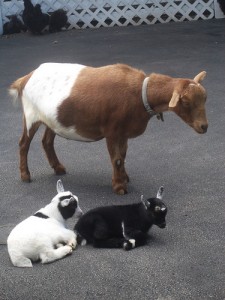 Breeding is one of the most exciting parts of raising goats. It’s a joy to see your flock grow bigger and besides, baby goats are so cute! If you’re thinking of breeding your goats there are a few things to keep in mind. Read on for a brief overview of the breeding process.
Breeding is one of the most exciting parts of raising goats. It’s a joy to see your flock grow bigger and besides, baby goats are so cute! If you’re thinking of breeding your goats there are a few things to keep in mind. Read on for a brief overview of the breeding process.
A female goat (a doe) is ready to breed when she is about a year old. You can also look at her weight to determine if she’s ready to breed. Usually a doe needs to be at least 75 pounds before her body is developed enough to take on the stress of breeding and birthing. You should also be sure that any does you choose to breed are strong and healthy. An overweight or sick doe may have a complicated birth, putting both her and her kids at risk.
A female goat is ready to breed in the fall. Usually she will go into heat two or three times each autumn. A doe that is in heat will tend to be noisy and will show more interest in male goats (bucks). She may also wag her tail a bit to get attention. When you notice that your doe is in heat, bring her aside with the buck that you use for breeding. If you don’t keep any bucks, you may be able to get in contact with other goat breeders and work out a deal. At this point there’s not much you need to do. You may want to bring the doe and buck together to breed several times over the next few days in order to increase the chances of conception.
After mating, separate your doe from the rest of the flock. Three or four weeks later you can check for pregnancy. A pregnant doe will usually be somewhat docile, so if you notice she’s just as frisky as ever or is showing signs of being in heat again it’s likely she’s not pregnant. If you think your goat is pregnant, get in touch with your vet. He or she can do ultrasounds or a blood test to confirm your suspicions. Don’t rely on sight to figure out if a kid is on the way, though. Even late in pregnancy it’s difficult to spot a pregnant doe by sight.
Goats have been giving birth by themselves for centuries and are instinctually able to do so now without your help. However, that doesn’t mean you need to leave her alone with the birthing time comes. On average, a doe will give birth 150 days after mating, but if she’s a few days early or a few days late there’s no need to be alarmed. Get ready for a mess. It’s a good idea to have lots of paper towels on hand to help clean things up. If you’re worried about whether your doe will have a healthy birth, get in touch with your vet and check her out beforehand. It may also be a good idea to have someone who’s been through a goat birth before on hand during your first birth.
When all is said and done, you’ll be left with one, two, or even three new kids to add to your flock. Your doe will also be able to make milk, which you can use to feed your family. Breeding goats is an exciting process for everyone involved, so don’t be scared to give it a try.
Pic by Digital Sextant.




[…] Source : beselfsufficient.net […]